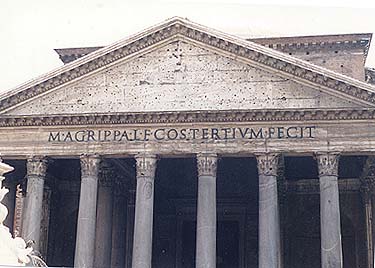|
|
 |
|
The Pantheon |
|
written
by asc1 / 09.08.2004 |
|
|
| |
Introduction |
| |
| |

|
| http://www.vroma.org/images/flood_images/ |
| Inscription on Pantheon |
| The inscription on the Pantheon translates to: "Marcus Agrippa, the son of Lucius, three times consul, built this." The inscription was a source of confusion for a long time regarding the origins of the building. |
| |
|
THE MYSTERY SURROUNDING THE PANTHEON’S ORIGINS
The inscription on the façade of the Pantheon translates to “Marcus Agrippa, the son of Lucius, three times consul, built this.” Generally such an inscription clarifies confusion surrounding the origins of a monument; in this case, it has been the source of conflict in the debate over when and by whom the Pantheon was built. Descriptions of the Pantheon are not prevalent in ancient literature, and so for a long time scholars hypothesized about the origins of the building.
The architecture only added to the confusion surrounding the Pantheon’s origins because there is a certain degree of discontinuousness between the three parts: the porch, the intermediate connecting block, and the rotunda. The Greek style columnar portico contrasts the Roman style rotunda. In addition, the relatively low porch next to the exceptionally high impediment of the rectangular intermediate block proves an awkward combination.
In an attempt to explain the inconsistencies of the building, many theories have been developed. Michaelangelo suspected that portions of the Pantheon were built by different architects who had varying levels of skill. Palladio believed that Agrippa had merely added onto an already existing Republican-era building. Beltrami recognized a Hadrianic influence, but also mistakenly believed that the Pantheon was built in separate portions.
It was not until the early 1900s that the controversy surrounding the origins of the Pantheon was brought to rest. Bricks from all parts of the building were studied for their stamps indicating the date when they were made, as well as the names of prominent government officials at the time. Dating of the bricks conclusively set the time range in which the Pantheon was built to be 120-128 AD. The beginning of construction may have begun as early as 118 AD to clear the space for the building’s foundations. This time period for construction proves the Pantheon was built under the reign of the Roman emperor Hadrian.
THE ORIGINAL BUILDING
The name Pantheon comes from the Greek words pan and theon, which mean all and gods, respectively. The Pantheon as it is known today was actually built on the site of another Pantheon that served as a temple for all the Roman gods. The first building was built by Marcus Agrippa around 27 AD to celebrate the victory of his father-in-law, the emperor Augustus, at Actium over Antony and Cleopatra. Located in the Campus Martius, the original building was rectangular and faced south. However, this building was completely destroyed by a fire. Domitian had the Pantheon restored in 80 AD, only to have it struck by lightening and burnt to the ground again in 110 AD. The destruction of the original Pantheon was considered a bad omen suggesting that the pagan gods were unhappy with the temple that was built to honor them. The remains of the Pantheon were thus left in place for nearly eight years until Hadrian became emperor and began his building program, which produced the Pantheon that still stands today.
HISTORY OF THE SPACE
Since its inception in 128 AD, the Pantheon has had a long history. Renovated by Septimius Severus and Caracalla, the Pantheon fell into disrepair, as did many Roman buildings, after Constantine moved the center of the empire from Rome to Constantinople. During the rise of Christianity, the Pantheon was abandoned and then pillaged by the Goths. By 600 AD, after the Tiber flooded, mud accumulated around the building and it is believed that the Pantheon might have become filled with dirt, allowing trees to grow inside. In 609 AD, Pope Boniface IV rededicated the Pantheon as the Church of Sancta Maria ad Martyres and according to legend a multitude of devils fled shrieking through the oculus when he did so. It is rumored that at this time, twenty-eight wagonloads of martyrs' bones were brought to rest at the Pantheon from the catacombs. The Pantheon was the first Roman temple to be consecrated as a church, and doing so saved it from ruin because the church dedicated a great deal of wealth to maintain the building. In 1101, after the popes moved to Avignon, the Pantheon served as a fortress in the struggles between the Colona and the Orsini, two rival Roman aristocratic families. Bernini also added two bell towers in the 1500s, which made the Pantheon appear more like a traditional church. However, the awkward appearance of the bell towers quickly earned them the nickname of “the ass-ears of Bernini” and they were consequently removed in 1883.
|
| |
|
| |
|
|
 |
|

